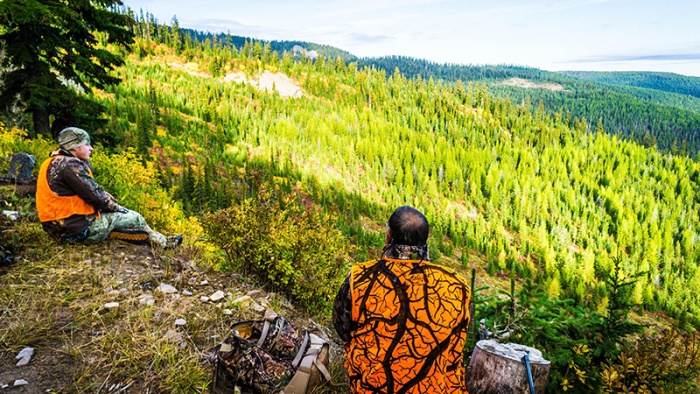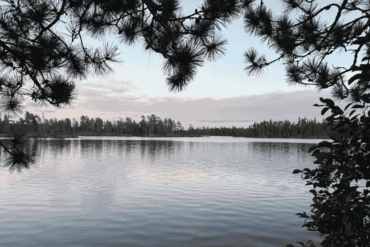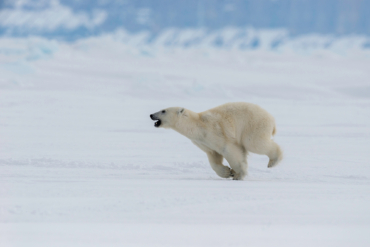We have a perfect solution we don’t use and benefactors we don’t thank. It may be time for a tax on outdoor gear.
“Holy shit! The importance of this issue cannot be understated.” When I read this email from Ryan Callaghan, director of conservation for First Lite, I began to see the scope of a looming crisis within the outdoor industry.
The number of hunters in America is on the decline — and it has been for some time. Callaghan, however, wasn’t just decrying the waning popularity of his sport. He and many others see a serious crisis on the horizon: hunting and fishing have largely bankrolled our public lands spending.
But that bankroll is shrinking while our public lands debt continues to mount.
Now, with a new proposal sent to congress from the Center of Western Priorities, it’s time for the entire outdoor industry to take a moment and figure out where it stands on one simple question with complicated repercussions: should we pay taxes on outdoors equipment to fund the maintenance of more than 640 million acres of public land we play on?
In short: The number of people buying hunting licenses has fallen 50 percent in the last half-century. This means less money is going to public land protections and habitat restorations in the wake of disasters like wildfires.
And though longstanding legislative measures provide a seemingly perfect solution, our public spaces face a massive — and growing — funding shortfall. We break down why the lands we all own are running out of money, who’s been paying for them up to now, and why a special tax on outdoor gear may help pick up the slack.
Public Lands: How We Fund Them Now
First, some background. Americans are blessed with vast tracts of public land to play on, and virtually all of us contribute to preserving acreage through Congressional appropriations of tax revenue.

But in the last half-century, the federal government has made expenses on natural resources a smaller and smaller portion of overall spending.
In its analysis of decade-over-decade government spending, the Property and Environment Research Center (PERC) — a “free market conservation and research institute” — found that federal spending on environmental protection and enhancement, recreation and wildlife areas, and the development and management of land, water, and mineral resources has dropped by more than half since the ’60s and ’70s (from roughly 2 percent of overall spending to less than 1 percent today).
Furthermore, while Americans also contribute to public lands in more direct ways — be it through park entrance fees, concession services, or donations — those constitute a fraction of park revenue. According to the National Park Service, revenues from park fees, concessions, and donations accounted for about 11 percent of its total budget authority in 2018.
For these reasons and more (outlined below), national parks, national forests, wildlife refuges, national monuments, and more remain woefully underfunded.
According to a non-partisan report by the Congressional Research Service, the four major land management agencies — the Bureau of Land Management, Fish and Wildlife Service, National Park Service, and Forest Service — have a combined maintenance backlog approaching $20 billion.
LWCF: The Best Program We Don’t Use
Perhaps the greatest tool the government and the people have to maintain and preserve our public lands is the Land and Water Conservation Fund (LWCF). Passed in 1965 to ease the public burden of funding national parks and other outdoor recreation areas, the LWCF is fully funded by offshore oil and gas leases.
This year, in fact, with bipartisan support in Congress, President Donald Trump signed a permanent reauthorization of the fund. This means going forward, lawmakers can use the LWCF to allocate up to $900 million a year to spend on national parks, public beaches, neighborhood playgrounds, and more.
Terrific, right? Sadly, not so much.
“Only once in the fund’s 54-year history has it been fully funded,” said Alex Boian, the Outdoor Industry Association’s (OIA) vice-president of government affairs. Boian’s terse summation targets the fund’s perennial gray area. Just because Congress can authorize nearly a billion dollars each year doesn’t mean it actually will.
The Department of the Interior admits as much on its site: “While $900 million in revenue is deposited into a designated account in the Treasury each year, Congress has appropriated full funding to support conservation and recreation projects only once in the Fund’s 50-year history — diverting the remainder for other purposes.”

Those “other purposes” have been a constant source of controversy. In a 2015 op-ed in Politico titled, “Why I Let the Land and Water Conservation Fund Expire,” Utah Rep. Rob Bishop argued the fund was “hijacked by special interests.”
According to him, “The government uses a fund that was intended to create greater public access to lands as a way to take away people’s property.”
Even though we now have the LWCF permanently on the books, this month’s report by Western Priorities points out that its passage did not include any funding.
Footing the Bill: How Hunting and Fishing Save Public Lands
Obviously, there’s a need for more money going to our shared public spaces, but there’s one more key to this story.
For more than 80 years, hunters and anglers have paid for the vast majority of conservation and wildlife management in the United States. That is because of two pieces of legislation: Dingle-Johnson and Pittman-Robertson. Those two landmark pieces of legislation date back more than 60 and 80 years, respectively.
Think of those acts as the lines of credit that have been keeping the lights on, even as federal spending has continued to wane. Through excise taxes on sport-specific gear — tackle, bullets, guns, etc. — and licensing fees, these acts direct money to state wildlife agencies to help protect and manage lands, habitats, and wildlife. In 2018, these two acts combined brought in and distributed more than $1 billion in funds.
In recent years, however, the support of those guarantors has begun to wane. A study by the U.S. Fish and Wildlife Service showed that as of 2016, there were one million fewer hunters age 16 and older than there were 10 years ago.
Additionally, NPR reported that the percentage of Americans who hunt today is half of what it was 50 years ago.
Hunting Decline Threatens Wildlife Conservation
“It’s tremendously serious; it’s how we do things,” said James Burnham, Hunting and Angling R3 Coordinator with the Minnesota Department of Natural Resources. “If we continue to lose hunters and anglers, we will no longer be able to manage our wildlife base. If you’re not in a natural resources degree program, you might not know that’s how a lot of this stuff gets paid for.”
“Imagine if we took away the gas tax and still wanted to have decent roads to drive on — no potholes, new bridges — it just wouldn’t be possible.”
Signed in 1937 by President Franklin D. Roosevelt, the Federal Aid in Wildlife Restoration Act — dubbed Pittman-Robertson after its sponsors Sen. Key Pittman and Rep. Absalom Willis Robertson — allocated an 11-percent excise tax on firearms and ammunition to the Department of the Interior. The Secretary of the Interior then distributes that money to each state, according to its land area and the number of licensed hunters there.
The result is a veritable windfall for state fish and game agencies to restore habitats, acquire new land, manage wildlife, conduct research, and more. To understand how crucial that money is for state wildlife agencies, Burnham offered up an analogy most of us can understand:
“Imagine if we took away the gas tax and still wanted to have decent roads to drive on — no potholes, new bridges — it just wouldn’t be possible,” he said.
Is a ‘Backpack Tax’ the Answer?
As a result of declining hunting numbers and balking by the federal government, some inside the outdoor industry have raised the prospect of a “backpack tax.” The idea is similar to the hunting excise tax.
“In the long run, as our elected officials no longer serve us, independent businesses have to continue to step up, listen to our customers, take a page from Dingell-Johnson and Pittman-Robertson, and provide funding through an excise on outdoor goods,” Callaghan said.
Just as Pittman-Robertson represented a “user-pay, user-play” model for hunters, so too would a backpack tax offer a fair and sustainable revenue source, proponents argue.
In its 2017 Outdoor Economy report, the OIA cited sales of gear for outdoor recreation totaled about $184.5 billion. As a rough estimate, taxing that gear in accordance with Pittman-Robertson and Dingell-Johnson rates of 3 to 12 percent, anywhere from $5.5 billion to $22 billion a year could be raised.
In fact, Washington state this year proposed a bill that would tax outdoor gear. But to quell heavy opposition — after all, who’s to say what exactly qualifies as “outdoor” gear? — the tax would only apply to qualifying products over $200.
“Hunters and anglers have been doing their part for years, and expanding this to the greater outdoor recreation community is an important next step,” this month’s report from Western Priorities cited.
Such a plan, however, faces huge opposition from an industry that, according to the OIA, already paid hefty taxes — about $650 million annually— through import tariffs before the Trump administration’s trade war with China. Plus, as of the writing of this story, the OIA released a new report that found “American outdoor businesses have paid an additional $2.6 billion in punitive tariffs over [2018].”
We reached out to several outdoor brands — REI, Patagonia, and The North Face — that all declined to comment on the issue of a backpack tax. But Rod Johnson and Elizabeth John of Midwest Mountaineering in Minneapolis immediately took a stand against the idea.
“A backpack tax would discourage people from being active outdoors,” Johnson said. “This would mean people would be less fit and increase what the government has to spend on healthcare.”
John elaborated, emphasizing the mental and physical benefits of an active, outdoors lifestyle. According to her, a tax on outdoor gear is self-defeating.
“It takes courage to try something new and difficult,” she said. “I hate to see more barriers added, especially for young people struggling to get the gear they need for a trip.”
How to Pay for Public Lands
And so the issue goes back and forth with no clear winner. Hunters, anglers, and many conservationists argue sportsmen have unfairly footed the bill for too long. The outdoor recreation sector claims revenue from sporting unfairly funnels into sport-specific species and habitats.
Even so, the two camps agree on the need to protect public lands and preserve the wildlife there.
“We’ve become too polarized on everything these days,” said Mark Norquist, board member of the Minnesota Backcountry Hunters and Anglers. “This is one of those scenarios where I see us coming together more — and appreciating what we share.”
Norquist favors an outdoor sales tax of some sort. And, like virtually everyone with a stake in conservation, he agrees the LWCF needs to be reauthorized and funded in full. While that seemingly perfect solution starves on Capitol Hill, those who appreciate a life outdoors would be wise to take stock of what makes it all possible.
“If you like clean air and water; if you like trail running, kayaking, or skiing, you had better hug a fisherman or a hunter,” Callaghan said. “Or start coughing up a few hundred dollars a year before you head for the trailhead.”









